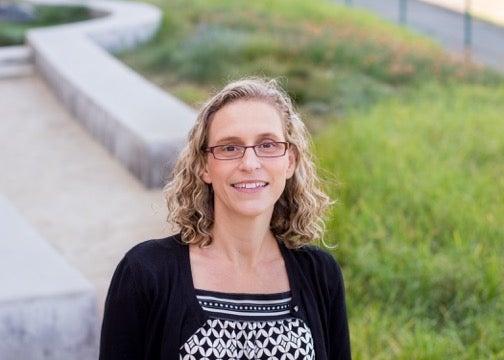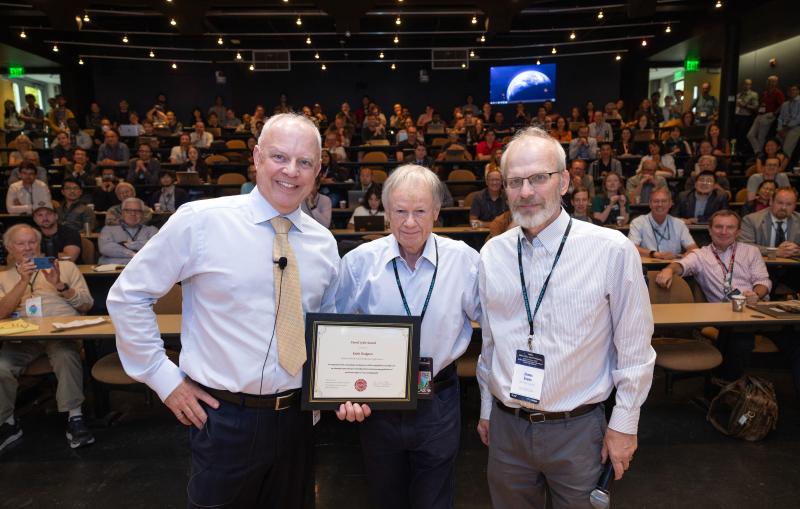Kathryn Hastie Wins Spicer Award for Lassa Virus Work at SLAC’s X-ray Synchrotron
The Scripps researcher is honored for groundbreaking research at the Stanford Synchrotron Radiation Lightsource that accelerated the development of a vaccine for deadly Lassa fever.
Kathryn Hastie, staff scientist at The Scripps Research Institute, has spent the last decade studying how the deadly Lassa virus – which causes up to half a million cases of Lassa fever each year in West Africa – enters human cells via a cell surface receptor.
Her efforts were recently rewarded when she solved the first structure of a surface glycoprotein for any member of the arenaviruses, the lethal family that includes Lassa, in experiments at the Stanford Synchrotron Radiation Lightsource (SSRL) at the Department of Energy’s SLAC National Accelerator Laboratory. The work was featured on the cover of Science and has been instrumental in accelerating development of a Lassa virus vaccine. She went on to determine three related structures with therapeutically relevant antibodies, all at SSRL.
In honor of her dedication and determination, Hastie has won SSRL’s 2017 William E. and Diane M. Spicer Young Investigator Award. The award is given each year to early-career X-ray scientists who perform research at SSRL, a DOE Office of Science User Facility.
In a nomination letter, Erica Ollmann Saphire, Scripps professor of Immunology and Microbiology, wrote that Hastie has “singlehandedly engineered a set of proteins from a major global health problem, solved multiple groundbreaking structures and provided revolutionary insights into all facets of the viral lifecycle,” adding that her work “is a game-changer for Lassa fever vaccines.”
Hastie said, “I am honored to join the ranks of the very accomplished Spicer Award recipients. It’s also very rewarding to be recognized for my contributions, having worked on this problem for so long.”
A Fascinating Virus Wreaks Havoc
Hastie came to Ollmann Saphire’s lab to study the Lassa virus as a graduate student with two bachelor’s degrees in different facets of biology from the University of Colorado. She finished her PhD in 2011 at Scripps and then stayed on as a post-doctoral fellow and now as a staff scientist.
Ollmann Saphire’s support for her work was a major factor contributing to her focus on solving the structure of Lassa’s viral machinery throughout the years, Hastie said. What started as a fascination for hemorrhagic viruses as an undergrad developed into a thorough understanding of the devastation they bring. Like Ebola virus, Lassa fever starts with flu-like symptoms and can lead to debilitating vomiting, neurological problems and even hemorrhaging from the eyes, gums and nose. The disease is 50 to 70 percent fatal when patients fall ill—and up to 90 percent fatal in pregnant women.
“I was captivated by how a virus like Lassa can cause such damage despite having only four proteins,” she said.
“During a time in my PhD work when I wasn’t having a lot of success, I took a trip to West Africa and saw the real consequences of this virus. It made the importance of the task much more real to me. We don’t ever see it in the United States, but in Africa, whole families are devastated by Lassa.”
Hastie worked with scientists at Tulane University and medical personnel at a clinic in Sierra Leone to raise and analyze human antibodies against the virus from Lassa Fever survivors. She then used the antibodies to engineer and re-engineer the glycoprotein to make it stable enough for X-ray crystallography studies, which would provide a map of the target on the virus where the antibodies need to attack.
The bright beam and “top-notch” detector at SSRL’s Beam Line 12-2 has been instrumental in her ability to map the Lassa virus structures, Hastie said.
“We do an enormous amount of screening and data collection on Beam Line 12-2. Just a month ago I was able to collect a new data set and solve a new structure for another type of antibody,” she said. “I don’t think we could have achieved what we have with a lesser beamline.”
Vaccines Within Reach
While working on the Lassa protein, Hastie also solved key structures of additional arenavirus proteins that are associated with other hemorrhagic fever viruses that cause death, neurological diseases and even birth defects around the world.
The Spicer Award selection committee chose Hastie based on her landmark success in solving multiple structures and her ongoing work on Lassa. “In addition, the research program that Dr. Hastie heads has global health impact, changes the field of biochemistry and illuminates the path forward for medically important viruses,” the committee wrote.
Hastie and Ollmann Saphire are confident that her work on Lassa will save lives – possibly tens of thousands of lives – within the foreseeable future.
“It is very likely that she will get to see vaccines and immunotherapeutics delivered to people in Sierra Leone, in the very clinic where she worked to raise those antibodies,” Ollmann Saphire said.
Hastie added, “Work is underway to get approval for some therapeutics, and we’ve just launched some studies to create vaccines based on our structures. Looking at the success others have had with Ebola, we feel pretty confident that in a few short years we might be able to do the same for Lassa.”
The Spicer Award will be presented to Hastie during the 2017 SSRL/LCLS Annual Users' Meeting and Workshops at SLAC. The award is named in honor of the late Stanford University Professor William Spicer and his wife Diane. William Spicer was a co-founder of the Stanford Synchrotron Radiation Project in 1972, which would later become SSRL.
The SSRL Structural Molecular Biology Program is supported by the DOE Office of Biological and Environmental Research, and by the National Institutes of Health, National Institute of General Medical Sciences.
For questions or comments, contact the SLAC Office of Communications at communications@slac.stanford.edu.
SLAC is a multi-program laboratory exploring frontier questions in photon science, astrophysics, particle physics and accelerator research. Located in Menlo Park, Calif., SLAC is operated by Stanford University for the U.S. Department of Energy's Office of Science.
SLAC National Accelerator Laboratory is supported by the Office of Science of the U.S. Department of Energy. The Office of Science is the single largest supporter of basic research in the physical sciences in the United States, and is working to address some of the most pressing challenges of our time. For more information, please visit science.energy.gov.





